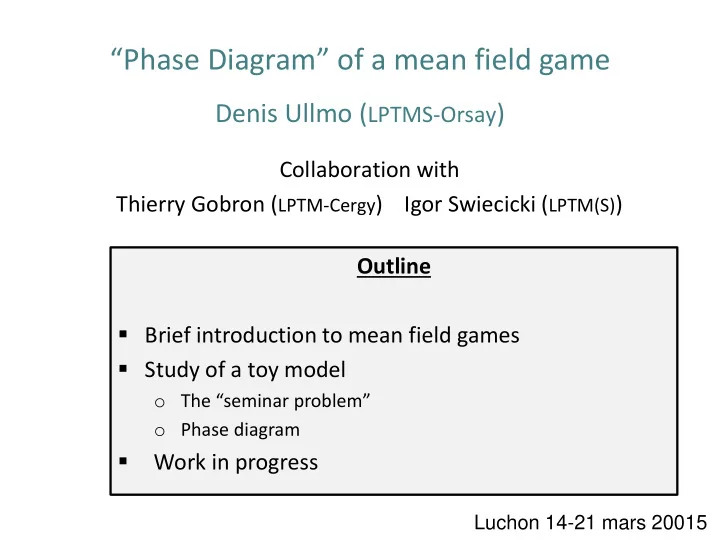

“Phase Diagram” of a mean field game Denis Ullmo ( LPTMS-Orsay ) Collaboration with Thierry Gobron ( LPTM-Cergy ) Igor Swiecicki ( LPTM(S) ) Outline Brief introduction to mean field games Study of a toy model o The “seminar problem” o Phase diagram Work in progress Luchon 14-21 mars 20015
Mean Field Games [Hawk and dove] Hawk Dove A simple game: (V-C)/2 , 2 players Hawk V,0 (V-C)/2 2 strategies Dove 0,V V/2, V/2 • As the number of players and strategies becomes large, the study of such games becomes quickly intractable. • However: « continuum » of strategy very large number of « small » players → Mean Field (differentiable) Games
General structure (e.g: model of population distribution) [Guéant, Lasry, Lions (2011)]
Mean Field Game = coupling between a (collective) stochastic motion and an (individual) optimization problem through the mean field Examples of mean field games Pedestrian crowds [Dogbé (2010), Lachapelle & Wolfram (2011)] Production of an exhaustible resource [Guéant, Lasry, Lions (2011)] (agents = firms, X = yearly production) Order book dynamics [Lasry et al. (2015)] (agents = buyers or sellers , X = value of the sell or buy order )
Two main avenues of research Proof of existence and uniqueness of solutions [cf Cardaliaguet’s notes from Lions collège de France lectures] Numerical schemes to compute exact solutions of the problem [eg: Achdou & Cappuzzo-Dolcetta (2010), Lachapelle & Wolfram (2011), etc …] Our (physicist) approach : develop a more “qualitative” understanding of the MFG (extract characteristic scales, find explicit solutions in limiting regimes, etc..)
For starters : study of a simple toy model “At what time does the meeting start ?”: [O. Guéant, J.M. Lasry, P.L. Lions] concerns for reluctance to desire not to the agent’s useless waiting miss the begining reputation
Shape of the cost function
Agents’ dynamics & optimization Seminar room
In practice, one must thus solve the system of coupled PDE :
NB : system of coupled PDE in the generic case
General strategy
Hamilton Jacobi Bellman (HJB) equation σ → 0 limit
σ → ∞ limit (backward diffusion equation with strange boundary conditions) One way to solve this : go back to original optimization pb distribution of first passage At x=0
Arbitrary σ
Kolmogorov equation Igor’s magical trick
Self consistency
“phase diagram” of the small Σ regime I. Convection regime 𝑢 III. T = IV. T ≈ 𝑢 II. Diffusion regime
Cut at small σ I a IV III I b
Cut at large σ II b I a II a III I b
Summary for the toy model Relevant velocity scales related to the slope of the cost function c(t). Limiting regimes : Convective vs Diffusive : Close vs far: Etc .. “Phase diagram” [arXiv:1503.01591 ]
Does it actually help us organizing a seminar ?
Does it actually help us organizing a seminar ? Of course not … Cost function presumably not the best one (should at least include the starting time). Geometry a bit simplistic. Dynamics = some version of the spherical cow.
Does it actually help us organizing a seminar ? Of course not … Cost function presumably not the best one (should at least include the starting time). Geometry a bit simplistic. Dynamics = some version of the spherical cow. Well …. this is just a toy model
Going toward more relevant problems Under what condition can a MFG model teach us something ? Dynamics, control parameter and cost function should bare some resemblance with reality (cf Lucas & Prescott model, or book order model). The optimization part should be “simple enough” (you may assume that agents are ‘rational’, you cannot expect all of them to own a degree in applied math).
Preference for present time
Recommend
More recommend